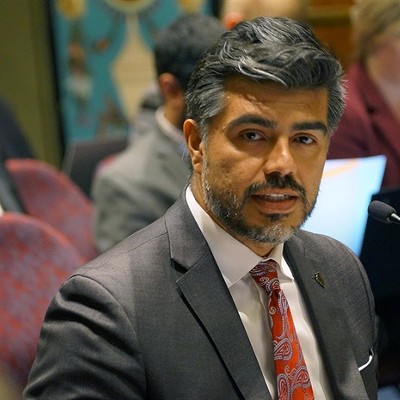Illinois Symphony votes to unionize
New orchestra executive begins work this month
[
{
"name": "Air - MedRect Combo - Inline Content 1",
"component": "11490391",
"insertPoint": "3",
"requiredCountToDisplay": "1",
"parentWrapperClass": "fdn-ads-inline-content-block"
},{
"name": "Air - MedRect Combo - Inline Content 2",
"component": "11490392",
"insertPoint": "7",
"requiredCountToDisplay": "5",
"parentWrapperClass": "fdn-ads-inline-content-block"
},{
"name": "Air - MedRect Combo - Inline Content 3",
"component": "11490393",
"insertPoint": "12",
"requiredCountToDisplay": "9",
"parentWrapperClass": "fdn-ads-inline-content-block"
}
]
The new season for the Illinois Symphony Orchestra brings not only new management, but also a recent announcement that musicians have voted to officially unionize.
On Oct. 20, representatives from the National Labor Relations Board sub-regional office in Peoria counted 64 ballots that were mailed in by ISO musicians. (The NLRB sent ballots to 107 regular full-time and part-time musicians employed by the symphony.) Fifty-nine of those musicians voted in favor of joining Local 301 of the American Federation of Musicians, a union that represents more than 90,000 musicians.
Amy Gilreath, a principal trumpet player who started with the symphony in 1999, says in the past, management operated the orchestra by its own rules. But now, musicians will have equal input into their audition procedures, working conditions and organization regulations.
“Unionizing the orchestra has to do with musicians having a say in what happens in the orchestra,” Gilreath says. “We’re the people who sit on the stage and play the music.
“We’re not trying to take over the orchestra. But when we have something to say, we need to be heard. And in the past, we feel that our voices have not been heard.”
Trevor Orthmann started as ISO’s new executive director on Oct. 5. Previously the eight-year president of Symphony in C in Camden, N.J., Orthmann has also played with east coast orchestras. He says ISO management supports the musicians’ decision to unionize.
“Sometimes it’s just a natural progression of the orchestra as they become more and more professional to become a union orchestra,” Orthmann says. “The major orchestras in the United States are union orchestras and have been for some time.”
Nathan Banks, a member of the first violin section who has also been with the symphony since 1999, says that a new contract will allow musicians to choose how rehearsals are conducted, as well as how symphony members are hired or fired.
The contract could also allow musicians to evaluate the performance of their music director, Karen Lynne Deal — which is a standard practice in most professional orchestras. ISO musicians voted 72-2 against Deal earlier this year in a formal vote of no confidence [see “Out of tune,” May 14].
Once they begin the negotiation process, Banks says, it could be anywhere from mere hours to many months before musicians and management agree on a contract.
“How long the negotiation takes depends on the participants,” he says. “I can’t imagine it’ll take that long, but you never know.”
Gilreath and Banks, who were both on the organizing committee during the unionizing process, agree that once an official contract is in place, musicians and management will have to work together to ensure that it’s enforced.
“I think it’s helpful for both parties, both for musicians and management, because it’s in black and white,” Gilreath says. “It’s a win-win situation, as far as I’m concerned.”
All ISO performances will continue as scheduled during union negotiations. The ISO’s next concert, the Halloween Pops, begins at 8 p.m. Oct. 31 at the Sangamon Auditorium.
“We’ll just continue to hope that our good relationships with our musicians does not change and we can continue to deliver the high quality performances that we have in the past,” Orthmann says.
Contact Amanda Robert at [email protected].
On Oct. 20, representatives from the National Labor Relations Board sub-regional office in Peoria counted 64 ballots that were mailed in by ISO musicians. (The NLRB sent ballots to 107 regular full-time and part-time musicians employed by the symphony.) Fifty-nine of those musicians voted in favor of joining Local 301 of the American Federation of Musicians, a union that represents more than 90,000 musicians.
Amy Gilreath, a principal trumpet player who started with the symphony in 1999, says in the past, management operated the orchestra by its own rules. But now, musicians will have equal input into their audition procedures, working conditions and organization regulations.
“Unionizing the orchestra has to do with musicians having a say in what happens in the orchestra,” Gilreath says. “We’re the people who sit on the stage and play the music.
“We’re not trying to take over the orchestra. But when we have something to say, we need to be heard. And in the past, we feel that our voices have not been heard.”
Trevor Orthmann started as ISO’s new executive director on Oct. 5. Previously the eight-year president of Symphony in C in Camden, N.J., Orthmann has also played with east coast orchestras. He says ISO management supports the musicians’ decision to unionize.
“Sometimes it’s just a natural progression of the orchestra as they become more and more professional to become a union orchestra,” Orthmann says. “The major orchestras in the United States are union orchestras and have been for some time.”
Nathan Banks, a member of the first violin section who has also been with the symphony since 1999, says that a new contract will allow musicians to choose how rehearsals are conducted, as well as how symphony members are hired or fired.
The contract could also allow musicians to evaluate the performance of their music director, Karen Lynne Deal — which is a standard practice in most professional orchestras. ISO musicians voted 72-2 against Deal earlier this year in a formal vote of no confidence [see “Out of tune,” May 14].
Once they begin the negotiation process, Banks says, it could be anywhere from mere hours to many months before musicians and management agree on a contract.
“How long the negotiation takes depends on the participants,” he says. “I can’t imagine it’ll take that long, but you never know.”
Gilreath and Banks, who were both on the organizing committee during the unionizing process, agree that once an official contract is in place, musicians and management will have to work together to ensure that it’s enforced.
“I think it’s helpful for both parties, both for musicians and management, because it’s in black and white,” Gilreath says. “It’s a win-win situation, as far as I’m concerned.”
All ISO performances will continue as scheduled during union negotiations. The ISO’s next concert, the Halloween Pops, begins at 8 p.m. Oct. 31 at the Sangamon Auditorium.
“We’ll just continue to hope that our good relationships with our musicians does not change and we can continue to deliver the high quality performances that we have in the past,” Orthmann says.
Contact Amanda Robert at [email protected].
Illinois Times has provided readers with independent journalism for almost 50 years, from news and politics to arts and culture.
Your support will help cover the costs of editorial content published each week. Without local news organizations, we would be less informed about the issues that affect our community..
Got something to say?
Send a letter to the editor and we'll publish your feedback in print!


















